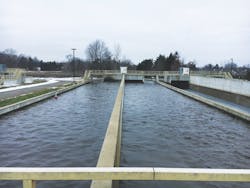Stephen J. Liebrecht is water and wastewater team lead for Rockwell Automoation. Liebrecht can be reached at [email protected].
Residential and industrial water treatment dates back thousands of years. From the Egyptians purifying drinking water through coagulation techniques to the Romans constructing aqueducts, water treatment has been a cornerstone of human civilization.
Some of those same antiquated techniques, such as coagulation and filtration, are still used today. But unlike ancient aqueduct bridges and sand, modern methods require technology to instantly serve thousands of residents and businesses at any time, regardless of location.
The Commerce Township Wastewater Treatment Plant (WWTP), located in Commerce Township, Mich., is one of many treatment facilities taking advantage of automation equipment; it treats more than 2 million gal of wastewater per day (mgd) from its community.
Bump in the Road
In 2010, the Commerce Township WWTP underwent a significant expansion project to meet the anticipated growth of the surrounding communities, nearly tripling its capacity from 2.4 to 8.5 mgd. After the installation of variable-frequency drives (VFDs), the Commerce Township WWTP hit a few bumps in the road.
“We were having numerous power interruptions that required our staff to reset process equipment,” said Brian Bennett, operations engineer for the Oakland County Water Resources Commissioner (WRC) in Commerce Township. “Over time, the interruptions were causing damage to our equipment. This equipment doesn’t fail immediately—it’s similar to hitting speed bumps in your car. You can go down the road and hit potholes only so long, but eventually it’s going to take its toll.”
After several months, the power interruptions resulted in multiple hours of unplanned downtime that required Commerce Township WWTP staff to manually reset equipment with limited insight as to the cause. After the interruptions resulted in two damaged VFDs, the township knew it needed to get to the bottom of the problem.
The Commerce Township Wastewater Treatment Plant hit a bump in the road when it installed variable-frequency drives to handle an expansion that nearly tripled its capacity from 2.4 to 8.5 mgd. Assessments of electrical usage identified the problems so the facilty could correctly address the cause.
Treat the Interruption
To identify the root cause, the Rockwell Automation Global Solutions team that installed the VFDs ran multiple equipment tests on the installed devices to determine if the problem was faulty equipment or the quality of the incoming power. According to Steve Liebrecht, water and wastewater industry team lead for Rockwell Automation, it is common for these small occurrences to go undetected because power utilities typically measure availability, not quality.
The team implemented the Allen-Bradley Bulletin 1608 i-Sense voltage monitor to collect, analyze and notify subscribers of incoming power quality. The monitor can interface with the Internet of Things using an analog phone line or a connection to existing IT infrastructure with an IP address. Once the data is collected, it is hosted in a web portal for customer use and also is integrated with other i-Sense monitors in the area to better understand regional power disturbances.
“The installation of the i-Sense voltage monitor allowed us to focus on specific periods of internal data and identify where the main problems were occurring,” Bennett said. “As a result, we were able to pinpoint the issues as they related to our incoming power.”
Once the voltage monitoring solution was installed, the WRC conducted a power quality study to better identify and document issues throughout the plant. The results allowed the Rockwell Automation team to confirm that voltage disturbances occurred at the same time the VFDs were tripped on overvoltage when running.
The monitor also alerted the facility about its generator power events. Fast generator shutdown and restart practices can impact the long-term durability of the drives. Controlled power cycling of VFDs should be managed in a methodical manner. For that reason, the WWTP heeded advice to adopt practices that would extend the life cycles of its VFDs.
Identifying the Cause
Within months of monitoring incoming power, Commerce Township determined the root cause of its failed VFDs.
“There were two reasons why we installed the i-Sense voltage monitor,” said Greg Knauf, Commerce Township WWTP superintendent. “One reason was due to our consistent power interruptions, and the other was a result of the two damaged VFDs. The data provided us documentation to go back to our power provider with results and work with them on addressing the power quality issues.”
While the Commerce Township WWTP now has data to work with its power provider to find quality interruptions, it has also gained a sense of reliability since the monitor’s implementation. Just one month after the product was installed, Knauf received an email from the monitor that indicated the WWTP experienced a power event. The WWTP’s SCADA system did not send out a notification to safety dispatch because the SCADA system was down.
“The moment I arrived home, I checked my laptop due to my concern of the WWTP’s equipment,” Knauf said. “Sure enough, 95% of the WWTP’s equipment was tripped.”
As a result, Knauf was able to call an operator to restart equipment and get the plant up and running. If the power event would have gone unnoticed, it could have greatly impacted the operation of the WWTP and compliance could have been affected.
Since the voltage monitoring system and power quality study, Commerce Township WWTP has been able to detect solutions to buffer incoming power events. During the evaluation phase, for instance, Rockwell Automation determined that although one transient surge suppressor was installed, multiple suppressors would be ideal. This safeguards operations because interruptions are based on a variety of factors, including the time and place of the event.
“One of the things that was enlightening to me was having clean power is not always the case,” Bennett said. “In fact, it might be to the point where it can damage electrical equipment. It doesn’t mean that fluctuations will damage everything, but it was eye-opening that fluctuations happen on a regular basis.”
Now Commerce Township uses its voltage monitoring system to troubleshoot power events with its provider while also mitigating its operation against future occurrences.
“The i-Sense voltage monitor has empowered management with data beyond what’s provided with the existing SCADA system,” said A.J. Lee, sales engineer for McNaughton McKay. “We’re hoping to continue the installation throughout other locations in the county so they are able to receive usable, actionable information.”


